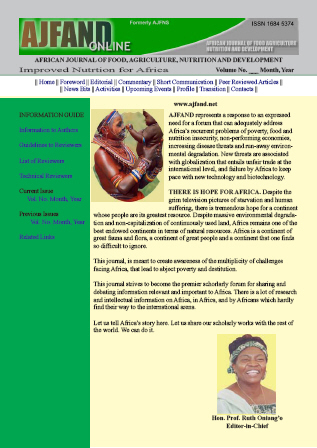
|
African Journal of Food, Agriculture, Nutrition and Development
Rural Outreach Program
ISSN: 1684-5358
EISSN: 1684-5358
Vol. 10, No. 3, 2010, pp. 2305-2323
|
 Bioline Code: nd10030
Bioline Code: nd10030
Full paper language: English
Document type: Research Article
Document available free of charge
|
|
|
African Journal of Food, Agriculture, Nutrition and Development, Vol. 10, No. 3, 2010, pp. 2305-2323
| en |
Assessment of Organochlorine Pesticides Residues in Fish Sold in Abidjan Markets and Fishing Sites
Biego, G. H. M.; Yao, K. D.; Ezoua, P. & Kouadio, L. P.
Abstract
This study aimed to investigate the organochlorine pesticide residues in fish sold in
markets and fishing sites in Abidjan, Côte d'Ivoire. Pesticides are not only used in
agriculture but also in public health for the prevention of malaria. However, pesticide
residues may be found in foodstuffs. Contamination of foods by pesticides can give
rise to carcinogenic, mutagenic and teratogenic effects. Pesticides are also
accountable for toxic effects on the nervous, immune, reproductive, renal, hepatic and
hematopoietic systems. For the present study, one hundred fish specimens
representing five fish species collected from markets and fishing sites were analyzed.
Analyses were performed with the help of a Gas Chromatograph (GC), brand Agilent
Instruments 6890N equipped with two micro-electrons capture detectors (μECD), two
Zebron capillary columns (ZB-5MS and ZB-1701P; 30 m x 0.25 mm x 0.25 μm), an
automatic injector and monitored by a microcomputer equipped with the ChemStation
plus software version 2002. The injection was done in Splitless mode and Nitrogen
N50 was used as vector gas. Of the 16 organochlorine pesticides considered in this
study, 11 were present in the samples analyzed, at various concentrations ranging
from 0.4 to 14.4 μg.kg-1 of fresh product. Samples were mostly contaminated by
Dichloro Diphenyl Dichloroethane (DDD). The catfish, with a total average
concentration (27.2 μg.kg-1 of fresh product) was the most contaminated species.
Heads (27.8 μg.kg-1 of fresh product) and viscera (17.5 μg.kg-1 of fresh product) were,
respectively the most contaminated parts of the fish species analyzed. The fishing port
of Vridi was the most contaminated site. The species collected on this site presented a
total average concentration of 24.4 μg.kg-1 of fresh product. The comparison of total
concentration mean of organochlorine pesticides in species collected, with the
maximum residue limits (MRL) set for the fishery products, suggests that health risks
faced by populations in Abidjan through fish consumption are currently low.
Keywords
Organochlorine pesticides, GC, fish, consumption
|
| |
© Copyright 2010 - African Journal of Food Agriculture, Nutrition and Development.
Alternative site location: http://www.ajfand.net/
|
|
